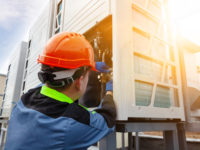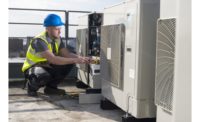HVAC providers are continuing to invest in multiple technology advancements to improve their systems’ energy efficiency and ability to provide effective heating and cooling, especially in locations where average outdoor temperatures are on the rise. One area where providers are investing is in improved design and insulation of HVAC enclosures, using the enclosure to lessen the impact of external temperatures on the equipment’s performance.
These improved enclosures can create a challenge for access panel design. The enclosures, typically constructed of steel, aluminum, or other sheet metal, protect the HVAC equipment; however, access panels must be incorporated into these structures to give technicians routine access to their interiors for servicing and repair tasks.
Increasing the insulation and strengthening the design of these enclosures can result in access panel doors that are both thicker and larger than past designs. Improved latching solutions are being developed to better secure these larger, thicker panels and ensure the energy efficiency of the enclosure. In addition, enclosure designers are utilizing more advanced hinge technology to enable the smooth and safe opening and closing of panels.
Complex cost containment challenges
Global inflationary pressures, combined with some of the significant challenges associated with ongoing supply chain disruptions related to COVID, are having an impact on both commercial facility and building operators and the HVAC systems manufacturers who supply them.
Costs for these systems can be significant, according to rough estimates from a 2022 industry blog:
- Recreational commercial buildings include gyms, basketball and tennis courts, golf ranges, ice skating rinks, swimming pools, etc. For such a commercial building, the HVAC system cost per square foot can be $22-$27.
- Small offices usually install 2-pipe HVAC systems that alternate the heating and cooling aspects in the same pipe — depending on seasonal needs. These HVAC systems may cost around $20-$28 per square foot.
- Larger offices, on the other hand, might employ the larger 4-pipe HVAC distribution. This uses separate pipes for the system’s hot and chilled water networks. The HVAC cost per square foot in this case would be around $28-$33.
Supply chain disruptions are also causing cost challenges for HVAC manufacturers and enclosure suppliers. COVID delayed many development projects that are now back on track. This creates added cost pressures as well as delays in meeting orders for suppliers with insufficient global manufacturing footprints and robust, reliable supply chains.
These trends are impacting HVAC enclosure design decisions in two ways. First, HVAC manufacturers are seeking enclosures that offer improved levels of insulation for their systems. This is particularly true in light of climate change-driven temperature increases in many regions.
In addition, climate change also appears to be fueling increased “extreme” weather events, including storms with much greater rainfall levels in short periods of time as well as incidents of extreme lower temperatures, ice storms, and other events. These have the potential to cause sudden intrusion of water and ice into sensitive HVAC electronic and mechanical equipment.
Increased insulation and new hardware choices

To help HVAC manufacturers and building owners respond to these changes, enclosure manufacturers are investing in design and hardware changes to help improve energy efficiency, prevent energy loss, and simplify certain access device choices.
Increasing insulation of the enclosure walls remains a strong trend. By installing thicker doors and panels with more insulation, measurable improvements in thermal efficiency and prevention of heat loss enable the HVAC units to provide the required heating/cooling load while better controlling energy demands.
Enclosure manufacturers are also standardizing their hardware purchases to better control costs, simplify engineering, and assure reliable supplies. In doing so, they need to make certain that hinges, latches, locking mechanisms, and other moving parts they standardize have the quality and long-term reliability required for these enclosures, which have the potential for decades-long use.
Access hardware address changes in enclosure designs
The increased use of insulated doors creates ongoing challenges for latching and hinges for HVAC enclosures. These doors need secure latching mechanisms and sturdy, reliable hinges — especially larger, heavier enclosure doors that are becoming standardized on many HVAC enclosures.
Insulated doors typically have two metal panels with a layer of foam material in between, creating doors that can be 25-75 millimeters and even up to 100 millimeters thick. They may also feature a compressible rubber bulb applied around the door opening that functions as a gasket to create a secure seal. Without secure latching, these doors can become weak points in the enclosure envelope.

Thicker doors with seals are designed to reduce energy loss from two kinds of leaks: infiltration and exfiltration. Infiltration is when unconditioned air leaks into the HVAC unit from outside, while exfiltration is leakage of air, typically conditioned air, from inside the unit through the casing to the outside. Both types of leakage increase the amount of energy required to supply conditioned air to the building.
Enclosure designs using double-walled doors still have one unavoidable point where leakage could occur: the door handle and latching mechanism, which must be put through the door. One way to minimize this impact is to select latches with handles with a compact design footprint to reduce the size of the hole that must go through the panel.
Another design consideration is thermal conductivity: If an all-metal latch and door handle is used and there is a significant temperature differential between the interior and the outside of the enclosure, condensation can form on the handle, causing drips and potentially degrading the performance of the mechanism. The condensation can also be perceived as implying that the enclosure isn’t fully protecting against energy loss. One solution that leading access hardware providers are offering is a latch that incorporates nonmetallic insulating components to provide a thermal break.
Some enclosure manufacturers are also exploring replacing steel with aluminum for the construction of entire enclosures or insulated access panels. This is being done due to supply chain constraints for steel as well as the desire to create more lightweight access panels. These lighter materials can come with a risk; however, the potential for large panels to improperly seal is greater.
One recent enclosure manufacturer used less expensive, more lightweight metal on its large insulated doors. The company also made the doors larger than in previous models to make accessing the HVAC interior easier. Unfortunately, the lighter-weight panels flexed significantly more than expected during shipping, warping them so that they could not make a tight seal when latched with a standard cam latch.
Working with a leading access hardware company, the enclosure manufacturer changed the latch hardware from a cam latch to a compression latch. This kind of latch holds a panel or cover closed with a cam and, at the same time, compresses a gasket around the inside of the door to seal it.
Ensuring a tight, reliable seal on an enclosure door can be a challenge for busy technicians if there is only a single latching mechanism in the middle of the door. In some cases, these doors have very large dimensions, so a single latch may not be sufficient to fully secure the door. Multipoint latching systems — which allow multiple latch points at the top, bottom, and middle of the door to be controlled by one actuator — can provide a simplified access solution for oversized doors.
When selecting a cam or compression latching solution for any enclosure door, it is important to consider environmental conditions. With the majority of HVAC equipment located outside, enclosure manufacturers must ensure their equipment meets environmental protection and durability requirements. Enclosure OEMs can maintain compliance by incorporating latches that are tested to UL, National Electrical Manufacturers Association (NEMA), or ingress protection (IP) standards.
Hinges improve access panel ergonomics

Like latches, hinges are an essential access component in the overall design of the HVAC enclosure. The technical capabilities of the latest hinge technology provide design engineers with new options for enhancing the ergonomics of the latest generation of insulated access panels.
When maintenance technicians open an enclosure door, they often want it to stay open while they access a control panel or perform equipment maintenance. Rather than attach an external door stay to prop it open, detent hinges allow a door to open to a preset angle and click into position. Constant torque hinges fulfill the same function with a greater range of possibility, providing smooth opening operation and infinite positioning of the door, opening as far as needed and remaining in position until pushed closed.
Numerous component suppliers have extensive experience evaluating and recommending the most effective and ergonomic latching and hinge components to select, based on a door’s dimensions, thickness, and weight.
While relatively simple, selecting the right latching and hinge access hardware can make significant contributions to sustaining an HVAC enclosure’s ability to insulate heating and cooling equipment and help keep energy costs under control.





